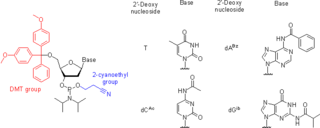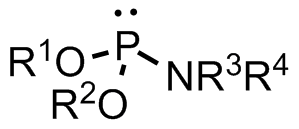History
The evolution of oligonucleotide synthesis saw four major methods of the formation of internucleosidic linkages and has been reviewed in the literature in great detail. [2] [3] [4]
Early work and contemporary H-phosphonate synthesis

In the early 1950s, Alexander Todd's group pioneered H-phosphonate and phosphate triester methods of oligonucleotide synthesis. [5] [6] The reaction of compounds 1 and 2 to form H-phosphonate diester 3 is an H-phosphonate coupling in solution while that of compounds 4 and 5 to give 6 is a phosphotriester coupling (see phosphotriester synthesis below).

Thirty years later, this work inspired, independently, two research groups to adopt the H-phosphonate chemistry to the solid-phase synthesis using nucleoside H-phosphonate monoesters 7 as building blocks and pivaloyl chloride, 2,4,6-triisopropylbenzenesulfonyl chloride (TPS-Cl), and other compounds as activators. [7] [8] The practical implementation of H-phosphonate method resulted in a very short and simple synthetic cycle consisting of only two steps, detritylation and coupling (Scheme 2). Oxidation of internucleosidic H-phosphonate diester linkages in 8 to phosphodiester linkages in 9 with a solution of iodine in aqueous pyridine is carried out at the end of the chain assembly rather than as a step in the synthetic cycle. If desired, the oxidation may be carried out under anhydrous conditions. [9] Alternatively, 8 can be converted to phosphorothioate 10 [10] [11] [12] [13] or phosphoroselenoate 11 (X = Se), [14] or oxidized by CCl4 in the presence of primary or secondary amines to phosphoramidate analogs 12. [15] [16] The method is very convenient in that various types of phosphate modifications (phosphate/phosphorothioate/phosphoramidate) may be introduced to the same oligonucleotide for modulation of its properties. [17] [18] [19]
Most often, H-phosphonate building blocks are protected at the 5'-hydroxy group and at the amino group of nucleic bases A, C, and G in the same manner as phosphoramidite building blocks (see below). However, protection at the amino group is not mandatory. [9] [20]
Phosphodiester synthesis

In the 1950s, Har Gobind Khorana and co-workers developed a phosphodiester method where 3'-O-acetylnucleoside-5'-O-phosphate 2 (Scheme 3) was activated with N,N'-dicyclohexylcarbodiimide (DCC) or 4-toluenesulfonyl chloride (Ts-Cl). The activated species were reacted with a 5'-O-protected nucleoside 1 to give a protected dinucleoside monophosphate 3. [21] Upon the removal of 3'-O-acetyl group using base-catalyzed hydrolysis, further chain elongation was carried out. Following this methodology, sets of tri- and tetradeoxyribonucleotides were synthesized and were enzymatically converted to longer oligonucleotides, which allowed elucidation of the genetic code. The major limitation of the phosphodiester method consisted in the formation of pyrophosphate oligomers and oligonucleotides branched at the internucleosidic phosphate. The method seems to be a step back from the more selective chemistry described earlier; however, at that time, most phosphate-protecting groups available now had not yet been introduced. The lack of the convenient protection strategy necessitated taking a retreat to a slower and less selective chemistry to achieve the ultimate goal of the study. [2]
Phosphotriester synthesis

In the 1960s, groups led by R. Letsinger [22] and C. Reese [23] developed a phosphotriester approach. The defining difference from the phosphodiester approach was the protection of the phosphate moiety in the building block 1 (Scheme 4) and in the product 3 with 2-cyanoethyl group. This precluded the formation of oligonucleotides branched at the internucleosidic phosphate. The higher selectivity of the method allowed the use of more efficient coupling agents and catalysts, [24] [25] which dramatically reduced the length of the synthesis. The method, initially developed for the solution-phase synthesis, was also implemented on low-cross-linked "popcorn" polystyrene, [26] and later on controlled pore glass (CPG, see "Solid support material" below), which initiated a massive research effort in solid-phase synthesis of oligonucleotides and eventually led to the automation of the oligonucleotide chain assembly.
Phosphite triester synthesis
In the 1970s, substantially more reactive P(III) derivatives of nucleosides, 3'-O-chlorophosphites, were successfully used for the formation of internucleosidic linkages. [27] This led to the discovery of the phosphite triester methodology. The group led by M. Caruthers took the advantage of less aggressive and more selective 1H-tetrazolidophosphites and implemented the method on solid phase. [28] Very shortly after, the workers from the same group further improved the method by using more stable nucleoside phosphoramidites as building blocks. [29] The use of 2-cyanoethyl phosphite-protecting group [30] in place of a less user-friendly methyl group [31] [32] led to the nucleoside phosphoramidites currently used in oligonucleotide synthesis (see Phosphoramidite building blocks below). Many later improvements to the manufacturing of building blocks, oligonucleotide synthesizers, and synthetic protocols made the phosphoramidite chemistry a very reliable and expedient method of choice for the preparation of synthetic oligonucleotides. [1]



















